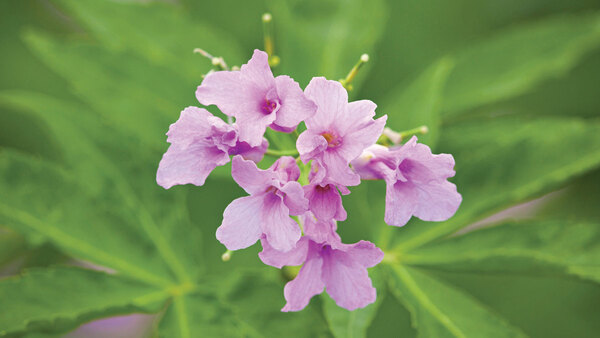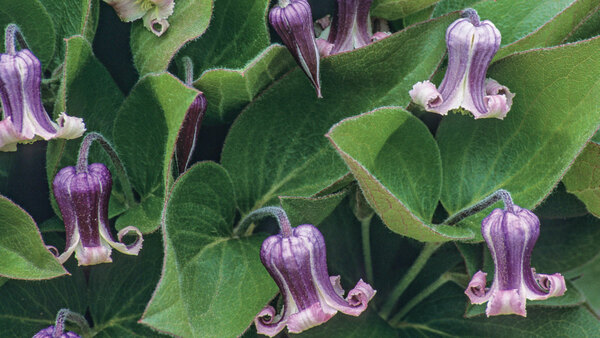
We all have certain plants that immediately come to mind when thinking of a garden in spring. For many, these are daffodils, tulips, and hyacinths skirting the trunks of flowering magnolias, cherries, and lilacs. But as William Cullina discusses in his article 9 Perennials to Liven Up Your Spring Garden, there are lots of out-of-the-ordinary or simply underappreciated plants that can elevate your spring garden to something spectacular.
Find some outstanding spring plants for California below. And discover even more surprising spring stars in 9 Perennials to Liven Up Your Spring Garden.
1. ‘Philippe Vapelle’ Geranium

Name: Geranium ‘Philippe Vapelle’
Zones: 5–8
Size: 12 inches tall and 18 inches wide
Conditions: Full sun to partial shade; well-drained soil
Native range: Hybrid
A choice, underused geranium, ‘Philippe Vapelle’ is a cross between two hardy European species: Renard geranium (G. renardii, Zones 6–8) and broad-petalled geranium (G. platypetalum, Zones 4–8). The flowers are an eye-catching, midtone purple with darkly veined petals, while the foliage is handsome, lobed, slightly velvety, and gray-green. The provenance of this geranium affords it more tolerance to heat and drought than many others in the genus, which are often from Asia. This is an excellent, low-growing plant for the front of sunny borders, rockeries, and containers. Prune it after flowering to tidy up and encourage regrowth. ‘Philippe Vapelle’ is drought tolerant once established.
2. ‘Aztec Pearl’ Mexican Orange

Name: Choisya × dewitteana ‘Aztec Pearl’
Zones: 7–10
Size: 5 to 8 feet tall and wide
Conditions: Full sun to partial shade; well-drained soil
Native range: Southwestern United States, Mexico
Mexican orange ranks among my favorite evergreen, spring-blooming shrubs. The hybrid selection ‘Aztec Pearl’ is particularly floriferous and is handsomely adorned with narrow, palmate foliage. Its fresh spring leaves are an intriguing pale green and grow darker over time. This plant is in the citrus family, so count on a lovely fragrance wafting about, particularly on warm evenings. ‘Aztec Pearl’ may rebloom in fall depending on climate and exposure. While it’s not overly fussy about culture, it should have adequate drainage. It’s drought tolerant once established but does appreciate some warm-season supplemental water. Prune it after flowering to control size and shape.
3. Black Coral Pea

Name: Kennedia nigricans
Zones: 8–10
Size: Up to 20 feet tall
Conditions: Full sun to partial shade; average soil
Native range: Western Australia
Black coral pea is an unusual and tough Australian vine for mild California climates. The genus Kennedia is in the pea family, so this plant bears foliage and flower similarities to peas that you might expect. But these characteristics are exaggerated, to say the least. This is a vigorous vine with bold foliage and dramatic black-and-green flowers that bloom from spring to summer. It’s a fine choice to grow along unsightly fences, walls, structures, and large slopes. Birds appreciate both the foliage cover and the flowers. Black coral pea is not overly fussy as long as it’s not standing in water, but it may need moderate warm-season supplemental water. Once established, though, it’s very drought tolerant.
4. ‘De La Mina’ Verbena

Name: Verbena lilacina ‘De La Mina’
Zones: 7–10
Size: 3 feet tall and wide
Conditions: Full sun to partial shade; well-drained soil
Native range: Cedros Island, Mexico
This pretty, compact, floriferous subshrub hails from an island off of Baja. This origin makes it an ideal choice for a Mediterranean-style, drought-adapted, sunny garden. The small but abundant flowers, which bloom in a cheery purple, do an excellent job of attracting insects and butterflies. Its heaviest period of flowering is in spring, but with some supplemental water and deadheading, it will produce flowers on and off all year. ‘De La Mina’ looks great in groups and drifts but can also be potted out in urns as an eye-catching focal point. It needs adequate drainage but has low water requirements once established. Shear it back to shape, and renew after flowering.
Anthony Garza is the supervisor of horticulture and grounds for the University of California Botanical Garden at Berkeley.
Fine Gardening Recommended Products

Gardener's Log Book from NYBG
Fine Gardening receives a commission for items purchased through links on this site, including Amazon Associates and other affiliate advertising programs.

ARS Telescoping Long Reach Pruner
Fine Gardening receives a commission for items purchased through links on this site, including Amazon Associates and other affiliate advertising programs.



















Comments
Log in or create an account to post a comment.
Sign up Log in